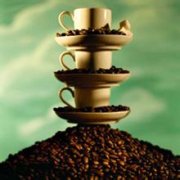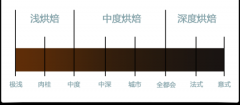Explain the general knowledge of roasting coffee beans with 8 roasting degrees.
First, when studying the roasting degree of coffee beans, the degree of roasting can be judged by sound, color and aroma.
Its color from light gray to dark brown, aroma from light and elegant gradually rich; the sound is issued twice burst sound, for example, heat-resistant raw beans, about 7 points began the first explosion, lasting about 2 minutes, its voice is low, indicating the beginning of pyrolysis, starch into caramel, water evaporation, exhaust, around 12 minutes issued a second explosion, the sound is violent and sharp, indicating that the cell fiber is broken, the deeper the baking.

Second, the famous American Fine Coffee Association (SCAA) promotes the determination of the baking degree by the caramelization analysis value (Agtron number) determined by the red inside. the higher the value, the lower the caramelization, the grayish color, and the lighter the baking. on the contrary, the low value represents the high caramelization, black and bright color, and the deeper the baking.
Third, the well-known roasting degree of coffee is the American term shallow roasting, medium roasting, deep (heavy) roasting, which can be subdivided into eight stages, and the difference of roasting degree varies with different regions. The following briefly introduces the roasting degree and flavor:
(1) Light Roast: very shallow baking, also known as "shallow baking"
Time to drop beans: before and after the start of the explosion
Wind taste: bean table is light cinnamon color, with a strong grass flavor, taste and aroma is not enough, generally used in experiments, rarely used as a product.
(2) Cinnamon Roast: shallow baking, also known as cinnamon baking
Time to drop beans: an explosion begins to be dense.
Wind taste: the bean surface is cinnamon color, at this time the smell of grass has been removed, strong acidity, slightly fragrant, often used to make American coffee.
(3) Medium Roast: medium baking, also known as "micro baking"
Time to drop beans: from the explosion to the end
Wind taste: the bean surface is chestnut color, light taste, slightly sour with bitter, moderate aroma, retain the original flavor of coffee beans, often used as American coffee or mixed coffee.
(4) High Roast: moderate micro-deep baking, also known as "concentration baking"
Time to drop beans: the end of the first burst
Wind taste: the bean surface is light reddish brown, the taste is refreshing and rich, the sour and bitter balance is not irritating, and it is slightly sweet, with good aroma and flavor. Blue Mountain and Gillimazaro coffee are suitable for this roasting degree and are loved by people in Japan and Central and Northern Europe.
(5) City Roast: medium-depth baking, also known as "urban baking"
The time to drop the beans: after the first burst, that is, between the first and second bursts.
Wind taste: the bean surface is light brown, the taste is bright and lively, the sour and bitter balance is light, and it releases the high-quality flavor of the coffee, which is the standard baking degree and the public's favorite roasting degree. Brazilian and Colombian coffee are suitable for this roasting degree and are often used in French coffee.
(6) Full City Roast: micro-depth baking, namely deep baking, also known as "deep city baking"
Time to drop the beans: the second burst
Wind taste: the bean surface is brown, the taste is calm and full, the bitter taste is strong, the aftertaste is sweet, the aroma is full, it is a Central and South American baking method, more iced coffee and black coffee are used.
(7) French Roast: very deep baking, also known as "French baking"
Time to drop beans: the second explosion is dense to the end of the second explosion.
Wind taste: the bean is dark brown and black, strong taste, bitter taste, sour taste almost no feeling, with strong chocolate and smoke aroma, for Europe by the most popular in France, more coffee Oulei, Viennese coffee.
(8) Italian Roast: extremely deep baking, also known as "Italian baking"
Time to drop the bean: the second explosion ends until the bean surface turns black and produces oil.
Wind taste: the bean surface is black and glossy. Before carbonation, the coffee bean fiber has a strong complex taste, strong bitter taste, with strong roasting and scorching aroma. It is mainly popular in Latin countries and Italy. It is often used as Italian coffee Espresso.
From the point of view of the baking degree, the deeper the baking degree, the stronger the bitter taste; the lighter the baking degree, the stronger the sour taste. The choice of baking degree depends on the characteristics of the coffee bean itself. for coffee beans with strong bitterness and light sour taste, they generally choose a moderate and shallow roasting degree.
Important Notice :
前街咖啡 FrontStreet Coffee has moved to new addredd:
FrontStreet Coffee Address: 315,Donghua East Road,GuangZhou
Tel:020 38364473
- Prev

Baking of high-quality coffee beans explanation on the roasting degree of coffee
First, when studying the roasting degree of coffee beans, the degree of roasting can be judged by sound, color and aroma. Its color ranges from light gray to dark brown, and its aroma is gradually rich from light and elegant; the sound is made two times of bursting sound. Taking the heat-resistant raw bean as an example, the first explosion begins at about 7 minutes and lasts for about 2 minutes, and its voice is low. It indicates the beginning of pyrolysis, the conversion of starch to caramel and water steaming.
- Next

The eight stages of coffee roasting
Coffee roasting-countries roast to cities around the world, all have their preferred roasting tendencies. In Tokyo, micro-deep medium baking is more popular, but slowly it also tends to deep baking. As for Kansai, deep baking has been popular in the past. New York, as its name suggests, generally prefers urban baking, but because it is inhabited by different races, it also sells
Related
- Beginners will see the "Coffee pull flower" guide!
- What is the difference between ice blog purified milk and ordinary milk coffee?
- Why is the Philippines the largest producer of crops in Liberia?
- For coffee extraction, should the fine powder be retained?
- How does extracted espresso fill pressed powder? How much strength does it take to press the powder?
- How to make jasmine cold extract coffee? Is the jasmine + latte good?
- Will this little toy really make the coffee taste better? How does Lily Drip affect coffee extraction?
- Will the action of slapping the filter cup also affect coffee extraction?
- What's the difference between powder-to-water ratio and powder-to-liquid ratio?
- What is the Ethiopian local species? What does it have to do with Heirloom native species?

